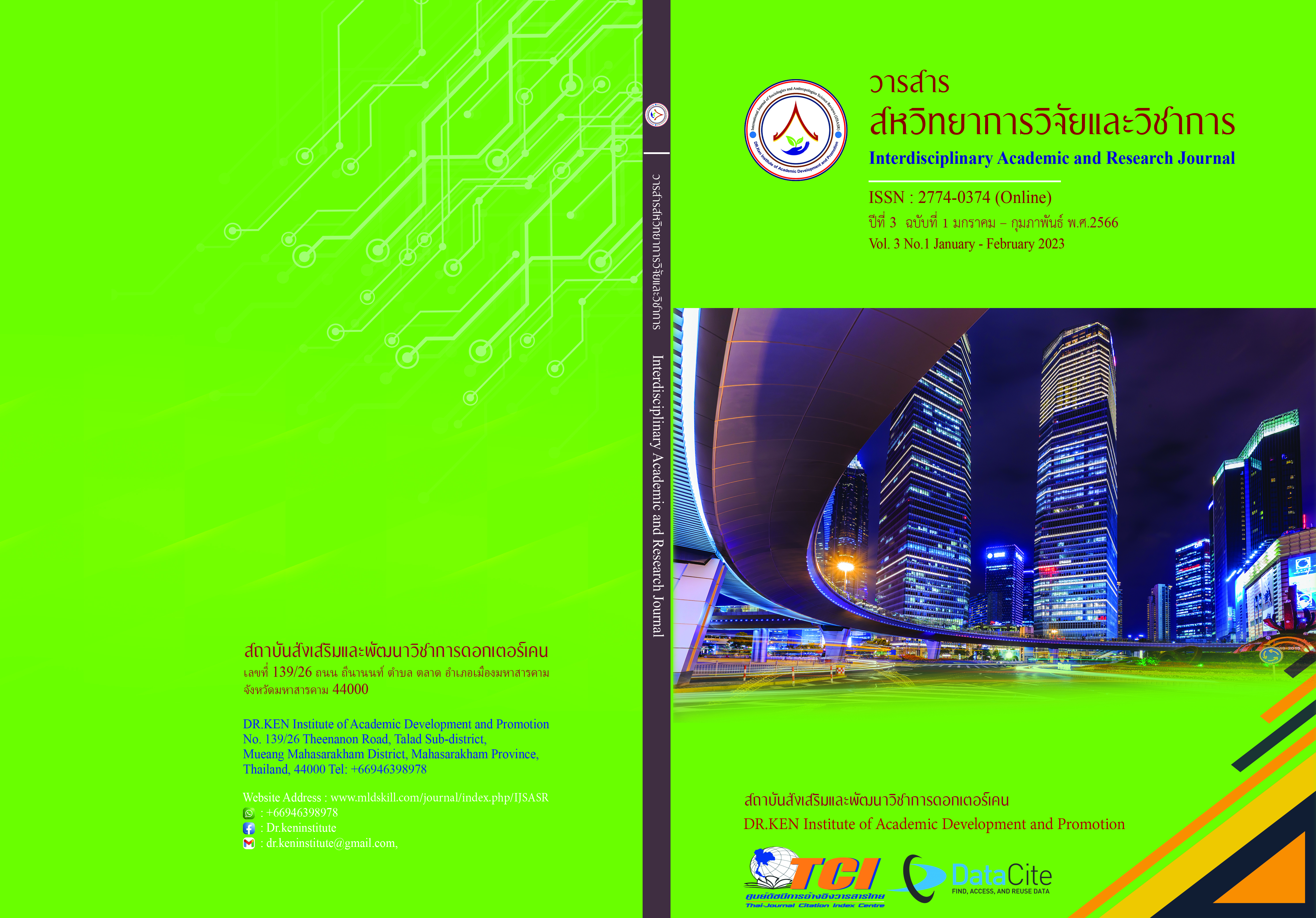The Equation of Predicting English Listening Comprehension Skill for Students Mattayomsuksa 6
DOI:
https://doi.org/10.14456/iarj.2023.39Keywords:
Listening Skill; , Listening Comprehension Skill; , English Listening Comprehension Skill; , the Secondary Educational Service Area Office Bangkok 2Abstract
English is a very popular language in society nowadays, and English listening skill is a skill that needs to be used in daily life. Besides, students must use English listening skills for communicating with foreigners, and students need to prepare for the English proficiency test to study at a higher education level. The purposes of this research were 1) to study the English listening comprehension skill of students Mattayomsuksa 6, 2) to study the correlation of predicted factors with English listening comprehension skill of students Mattayomsuksa 6, 3) to study a prediction equation for English listening comprehension skill of students Mattayomsuksa 6. The sample population consisted of 434 from the Secondary Educational Service Area Office Bangkok 2. students Mattayomsuksa 6. Using Multi-stage Sampling. The research instrument was 1) questionnaires of students Mattayomsuksa 6 and 2) an English listening comprehension skill test. Data were analyzed using Multiple Regression Analysis Enter Estimation. Results showed that 1) Student of students Mattayomsuksa 6 had a mean score of English listening comprehension skill was 49.07, and the standard deviation was 18.51. 2) The predicted variables were correlated statistically significant level of .05 3) The prediction equation for English listening comprehension skill of students Mattayomsuksa 6 using Multiple Regression Analysis by Enter method showed that the predictor variables could explain the dependent variable (R2) at 24.00 and the statistically significant level of .05 were 1) academic background knowledge 2) English language background knowledge 3) technique of listener and 4) teaching methodology.
References
ชัยวัฒน์ บวรวัฒนเศรษฐ์. (2563). การศึกษาสภาพการเรียนรู้นอกชั้นเรียน ปัจจัยที่มีอิทธิพล และ ความสามารถในการฟังภาษาอังกฤษเพื่อความเข้าใจของนักเรียนนายเรือชั้นปีที่ 4 โรงเรียนนายร้อยพระจุลจอมเกล้า. วารสารวิชาการมนุษยศาสตร์และสังคมศาสตร์, 7. 37-50.
พรชนก สุขพันธ์. (2560). ผลกระทบของสำเนียงภาษาอังกฤษที่หลากหลาย พื้นฐานความรู้เฉพาะและกลยุทธ์ในการสอบต่อทักษะการฟังเพื่อความเข้าใจของผู้เรียนภาษาอังกฤษเป็นภาษาต่างประเทศที่มีระดับความสามารถสูงและต่ำ. วิทยานิพนธ์ครุศาสตร์ดุษฎีบัณฑิต มหาวิทยาลัยจุฬาลงกรณ์.
สถาบันทดสอบทางการศึกษาแห่งชาติ. (2562). รายงานสรุปผลการทดสอบทางการศึกษาระดับชาติขั้น พื้นฐาน (O-NET) ระดับชั้นมัธยมศึกษาปีที่ 6. Retrieved 2 May 2021, from: shorturl.at/eDTU9
สำนักงานคณะกรรมการการศึกษาขั้นพื้นฐาน. (2551). ตัวชี้วัดและสาระการเรียนรู้ภาษาต่างประเทศ ตามหลักสูตรแกนกลางการศึกษาขั้นพื้นฐาน พุทธศักราช 2551. กรุงเทพมหานคร: โรงพิมพ์ชุมชนสหกรณ์การเกษตรแห่งประเทศไทย จำกัด.
Assaf, H. (2015). The difficulties encountered by EFL learners in listening comprehension as perceived by ELC Students at the Arab American University. Master’s thesis of Arts in English Methodology Nablus An-Najah National University.
Azmi, B. M., Celik, B., Yidliz, N., & Tugrul, M. C. (2014). Listening Comprehension Difficulties Encountered by Students in Second language Learning Class. Journal of Educational and Instructional Studies in the World, 4(4), 1-6.
Bloomfield, A., Wayland, S. C., Rhoades, E., Blodgett, A., Linck J., & Ross, S. (2010). What makes listening difficult? Factors affecting second language listening comprehension. College Park University of Maryland Center for Advanced Study of Language.
Bourdeaud’hui, H., Aesaert, K., & Braak, V. J. (2020). Identifying student-and class-level correlates of sixth-grade students’ listening comprehension. Educational Studies in Language and Literature Journal, 20, 1-38.
Chang, A., & Wu, W. B. (2013). Second Language Listening Difficulties perceived by Low-Level Learners. Perceptual & Motor Skills, 116(2), 415-434.
Fathi, J., Derakhshan, A., & Torabi, S. (2020) The Effect of Listening Strategy Instruction on Second Language Listening Anxiety and Self-Efficacy on Iranian EFL Learners. SAGE Journal. April-June 2020, 1-13.
Gulec, S., & Durmus, N. (2015). A study Aiming to Develop Listening Skills of Elementary Second Grade Students. Social and Behavioral Sciences, 191(15), 103-109.
Hermawan, H. (2012). Menyimak Keterampilan Berkomunikasi yang Terabaikan. Yogyakarta: Graha Ilmu.
Kurniawati, D. (2019). Factors affecting the learning listening English. English Education: Jurnal Tadris Bahasa Inggris, 12(2), 25-41.
Nushi, M., & Orouji, F. (2019). Investigating EFL Teachers’ View on Listening Difficulties Among Their Learners: The Case of Iranian Context. Faculty of Letters and Human Sciences, Shahid Beheshti University, 1-16.
Ramli, Mukminatien N., Saukah, A., & Prayogo, J. A. (2019). Word Recognition from Speech, Syntactic knowledge, Metacognitive Awareness, Self-Efficacy as determination for L2 Listening Comprehension. International Journal of Instruction, 12(3), 89-104.
Reza, Z. S., Bahri, Y. S., & Erdiana, N. (2019). Factors Affecting Listening Comprehension. Research in English and Education (READ), 4(4), 155-167.
Rost, M. (2011). Teaching and researching listening. 2nd ed. London: Longman.
Tarigan, H. G. (2015). Menyimak Sebagai Suatu Keterampilan Berbahasa. Bandung Angkasa.
Taysi, E. K. (2019). The Effect of Listening Attitude and Listening Anxiety on Listening Comprehension. Universal Journal of Educational Research, 7(2), 356-364.
Thepvongsa, C., & Klinchan, N. (2020). A Study of Problems in English Listening Comprehension of Matthayomsuksa Students. Master’s Thesis of Arts in English. Chulalongkorn University.
Watthajarukiat, T., Chatupote, M., & Sukseemuang, P. (2012). An Investigation of English Listening Strategies Used by Thai Undergraduate Students in Public Universities in the South. Journal of Liberal Arts, 4(2), 1-17.
Xuyen, N. T. (2020). Factors affecting English listening comprehension: Perceptions of English Major Students at HUFI, 288-305.
Yamane, T. (1967). Statistics An Introductory Analysis. 2nd Edition. New York: Harper and Row.
Downloads
Published
How to Cite
Issue
Section
License
Copyright (c) 2023 Chanthida Sen, Darunee Tippayakulpairoj, Kamontip Srihaset

This work is licensed under a Creative Commons Attribution-NonCommercial-NoDerivatives 4.0 International License.
Copyright on any article in the Interdisciplinary Academic and Research Journal is retained by the author(s) under the under the Creative Commons Attribution-NonCommercial-NoDerivatives 4.0 International License. Permission to use text, content, images, etc. of publication. Any user to read, download, copy, distribute, print, search, or link to the full texts of articles, crawl them for indexing, pass them as data to software, or use them for any other lawful purpose. But do not use it for commercial use or with the intent to benefit any business.
















.png)


